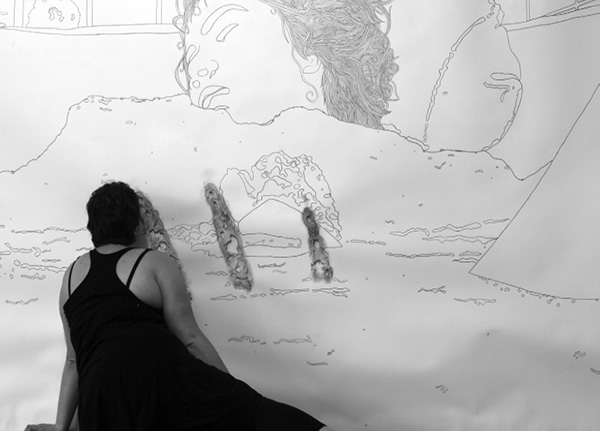
NIGHTMARE ON ELM STREET FROM THE BIG LICK SERIES
first performed on
July 14, 2011
Catalyst Art Gallery, Belfast, Northern Ireland
performed once in 2011
JENNY KEANE
Belfast, Northern Ireland
484787448j484787448e484787448n484787448n484787448y484787448k484787448e484787448a484787448n484787448e484787448@484787448h484787448o484787448t484787448m484787448a484787448i484787448l484787448.484787448c484787448o484787448m
jenny-keane.com
NIGHTMARE ON ELM STREET FROM THE BIG LICK SERIES
JENNY KEANE
Drawing has an experiential quality; it is a tracing of movement that imbricates both the temporal and the spatial. Developing out of a series of small drawings (“The Lick Drawings”), “The Big Lick Series” is created by tracing specific stills taken from horror films projected via a data projector-and then I lick out the “horrific” element therein. Ironically, the abrasive paper and the pressure of the licking action causes my tongue to bleed, and the disgusting or monstrous part of the image is actually replaced by my blood and saliva. I am “helping” the image by removing its horrific element, but I am also giving it a part of me-something that is just as horrific. I feel that the action is a removal of the metaphorical abject into the literal.
Being 2.4 x 3.6 m, the scale of “Nightmare on Elm Street from The Big Lick Series” allowed the audience to view the experience of my, usually hidden, action of drawing. I am interested in the performativity of this technique of drawing; the dark room, how my body breaks up the projected image and distorts the light while trying to trace the film still-it positions the female body back into the cinematic, not as “image” but as an active and disruptive physical presence-but one that is frighteningly shrouded in shadow, dichotomously evoking an apparition. By licking the drawing, I have given the drawing a part of me, my saliva and blood, and I have taken a part of it, broken up and ingested it-it is almost an experience of reciprocity. The wounded surface of the image transcends the “inorganic trace of life” in film-the image has been “touched” by reality. The fragmented narrative can be reanimated only through an uncanny memory of the film. The fleeting image on screen has been laboured over, traced and solidified onto the paper, and the saliva and blood firmly positions the physical corporeality of the female body back onto the surface of the cinematic screen; the performative action in the space creates a visceral and connected moment that literalizes the sexual, sensual, and abject experience.
The piece alludes to life and death, and becomes both intimate and disgusting, masochistic and voyeuristic-a space that transgresses the fetishistic investment in the image of the feminine in cinema, fragments narrative, and subsequently repositions the female body. “The Big Lick” creates a space of liminality.